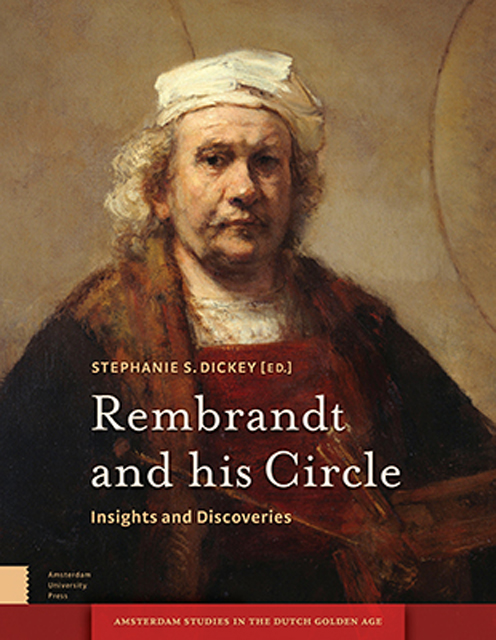Book contents
- Frontmatter
- Dedication
- Contents
- Acknowledgements
- Introduction
- 1 Rembrandt and Frans Hals Painting in the Workshop of Hendrick Uylenburgh
- 2 Rembrandt and the Germanic Style
- 3 Rembrandt and the Humanist Ideal of the Universal Painter
- 4 Curiosity and Desire: Rembrandt’s Collection as Historiographic Barometer
- 5 Painted Landscapes by Lievens and Rembrandt : The View from Seventeenth-Century Amsterdam Collections
- 6 Jan Lievens in Antwerp: Three Rediscovered Works
- 7 Gerrit Dou as a Pupil of Rembrandt
- 8 A New Painting by Jan van Noordt in Budapest
- 9 Rembrandt’s First Nude? The Recent Analysis of Susanna and the Elders from Rembrandt’s Workshop
- 10 Rembrandt’s Head of Christ: Some Technical Observations concerning Matters of Style
- 11 A Rediscovered Head of John the Baptist on a Platter from Rembrandt’s Studio
- 12 Rembrandt’s One Guilder Print: Value and Invention in ‘the most beautiful [print] that ever came from the burin of this Master’
- 13 Rembrandt, Ferdinand Bol, and Tobit: The Emergence of a Pathosträger
- 14 Biblical Iconography in the Graphic Work of Rembrandt’s Circle
- 15 Jan van Vliet and Rembrandt van Rijn: Their Collaboration Reassessed
- 16 Printmaking among Artists of the Rembrandt School
- 17 Chain Line Pattern Matching and Rembrandt’s Prints
- List of Illustrations
- Bibliography
- Index Nominum
17 - Chain Line Pattern Matching and Rembrandt’s Prints
Published online by Cambridge University Press: 21 January 2023
- Frontmatter
- Dedication
- Contents
- Acknowledgements
- Introduction
- 1 Rembrandt and Frans Hals Painting in the Workshop of Hendrick Uylenburgh
- 2 Rembrandt and the Germanic Style
- 3 Rembrandt and the Humanist Ideal of the Universal Painter
- 4 Curiosity and Desire: Rembrandt’s Collection as Historiographic Barometer
- 5 Painted Landscapes by Lievens and Rembrandt : The View from Seventeenth-Century Amsterdam Collections
- 6 Jan Lievens in Antwerp: Three Rediscovered Works
- 7 Gerrit Dou as a Pupil of Rembrandt
- 8 A New Painting by Jan van Noordt in Budapest
- 9 Rembrandt’s First Nude? The Recent Analysis of Susanna and the Elders from Rembrandt’s Workshop
- 10 Rembrandt’s Head of Christ: Some Technical Observations concerning Matters of Style
- 11 A Rediscovered Head of John the Baptist on a Platter from Rembrandt’s Studio
- 12 Rembrandt’s One Guilder Print: Value and Invention in ‘the most beautiful [print] that ever came from the burin of this Master’
- 13 Rembrandt, Ferdinand Bol, and Tobit: The Emergence of a Pathosträger
- 14 Biblical Iconography in the Graphic Work of Rembrandt’s Circle
- 15 Jan van Vliet and Rembrandt van Rijn: Their Collaboration Reassessed
- 16 Printmaking among Artists of the Rembrandt School
- 17 Chain Line Pattern Matching and Rembrandt’s Prints
- List of Illustrations
- Bibliography
- Index Nominum
Summary
Abstract
This report describes an ongoing project initiated in late 2012 to investigate the use of chain line pattern (CLiP) matching for the detection of mould mates (sheets made from the same papermaking mould) in the European paper used for printing Rembrandt's etchings. We investigate the application of computer-based image processing tools to mark, measure, and compare the idiosyncratic intervals of chain lines as recorded in beta-radiographs of individual sheets in the hunt for mouldmates. Results indicate that CLiP has strong potential for investigating and matching papers used by Rembrandt and other early modern printmakers. It provides a new method that can identify related objects even in the absence of a watermark.
Keywords: Rembrandt van Rijn, chain line pattern matching, papermaking, watermarks, Medea
Background
The study of Rembrandt's prints has occupied scholars for over two centuries. With several thousand impressions in existence today, the study of his printing papers occupies a prominent place within this scholarship. Rembrandt's prints were predominantly executed on antique laid papers. Until the widespread adoption of the papermaking machine in the early nineteenth century, paper was made by scooping up macerated and suspended paper pulp from a vat using a rectangular mould comprised of a porous screen surrounded by a removable wooden frame. Prior to 1750, the screen was fabricated from fine, densely spaced horizontal rows of laid wires secured by thicker, more widely spaced vertical chain wires. When the mould was plunged into the vat and lifted out, the wires acted as a sieve, filtering out the pulp in thinner and thicker accumulations depending upon how much interference they produced as the water drained through. The crisscrossed pattern of chain and laid lines is thus replicated in the final sheet of paper. Because the paper is thinner in areas corresponding to the wire grid, the laid and chain line pattern can be easily seen when the paper is held up to the light. Two papers will have identical laid and chain line patterns if they have been formed at the same time in the same manner on the same mould – hence they are called mouldmates.
- Type
- Chapter
- Information
- Rembrandt and his CircleInsights and Discoveries, pp. 319 - 334Publisher: Amsterdam University PressPrint publication year: 2017



